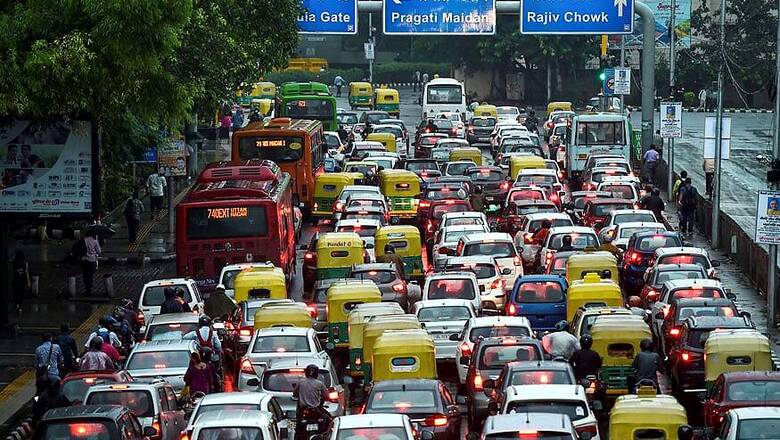Delhi’s 'Odd-Even' Fight Against Pollution and Curious Case of Missing Buses That Dates Back to 1998

views
New Delhi: The odd-even car rationing scheme in Delhi kick-started on Monday amid murky skies and equally murky politics. Delhi BJP leader Vijay Goel denounced the scheme as a “gimmick” and flouted rules when he left his home in an odd-numbered car on day when only even-number cars were allowed.
“The (Delhi government) says that the pollution is due to stubble burning, then how does this scheme help?” he asked. The AAP, meanwhile, countered with chief minister Arvind Kejriwal maintaining that Delhi is the only city where the “pollution has decreased”.
But in this quagmire of politics, plaints and pollution, one question remains unanswered: where are Delhi’s buses? The odd-even scheme, after all, is aimed at decreasing the number of vehicles on the road by incentivising its citizens to use public transport.
It was in 1998, when the capital was in the grip of another pollution emergency, that the Supreme Court had directed the capital city to ensure that its bus fleet be increased to 10,000 and that they be converted to CNG.
That was then. Successive governments have come and gone, but the magic figure of 10,000 was never really attained. Today, the figure has been revised to 11,000 and the capital is looking for yet another shift in fuel – to electric. “Things are on track. But admittedly, the progress has been slow,” said an official.
As things stand, Jasmine Shah, chairperson of the Delhi Dialogue Commission said that there are a total of 4,000 buses slated to hit Delhi roads--- 1,000 standard floor buses, 1,000 low floor cluster buses by, 1,000 low floor DTC buses and 1,000 electric buses.
Dead Mileage and No Man’s Land
When the AAP government led by Kejriwal took oath for a second time in 2015, Delhi had about 5,500 buses and depot space for just 6,000 buses. The party’s manifesto had promised 10,000 buses to the capital. “But you can’t order the buses right away. You have to build additional depot capacity,” explained Jasmine Shah, chairperson, Delhi Dialogue Commission.
Since 2015, the government worked on building capacity for 4,000 buses. “We had to fight the landowning agency, and in most cases we have taken the land in the periphery of Delhi – that is the reason it has taken long,” said an official, adding that the fact that these buses were built in a “no man’s land” would increase the “dead mileage”. Dead mileage is when a revenue-gaining vehicle operates without carrying or accepting passengers, such as when coming from a garage to begin its first trip of the day.
The Environment Pollution (Prevention and Control) Authority had earlier submitted in the court that around 134 acres of additional land was required to house the new fleet of buses. “This was the reason why the induction of the new buses has been delayed. The government had essentially no spare capacity of infrastructure to really build on what we had…and then we started ordering the buses,” said the official.
Statistics from the transport department show that there has been an increase of 41 percent in the total bus depot capacity, with the creation of depot infrastructure that could house 2,366 more buses – taking the total to 8,131. But even then, the procurement of buses was
delayed by a case in the Supreme Court and finally, in 2017, the Delhi cabinet began pushing for buses in earnest.
Tender Troubles and an Electric Dream
In May 2018, a tender for 1,000 standard floor buses failed after only Tata Motor came up and became yet another failed tender in what has been a consistent problem for the Delhi government in trying to procure more buses.
With just two companies – Tata Motors and Ashok Leyland – making low floor buses, an official described the situation as “very much a manufacturers market where they dictate the prices” and “on average one of three tenders fail”. The official added, “There is another company…JBM buses which is also making buses, so the situation has slightly improved.”
The Delhi government is hopeful that with the electric buses – which Shah describes as the “future of public transport” – things will improve significantly. “There are more players in the electric bus manufacturing than in the usual ones,” Shah added.
The AAP government hopes to pave the path for future public transport systems in different cities by its emphasis on electric vehicles. Its draft policy has two main aims, improve Delhi’s air and create jobs in driving, selling, financing, servicing and charging of electric vehicles.
The first part of the plan is to focus on a large scale adoption of electric vehicles, with an emphasis on public transport. Then, to create the infrastructure to charging facilities at every 3 kilometers while encouraging the re-use and recycling of batteries. Then, the draft plans, to implement a “feebate concept” to “fund a high proportion of the incentives proposed in the policy. 5”.




















Comments
0 comment